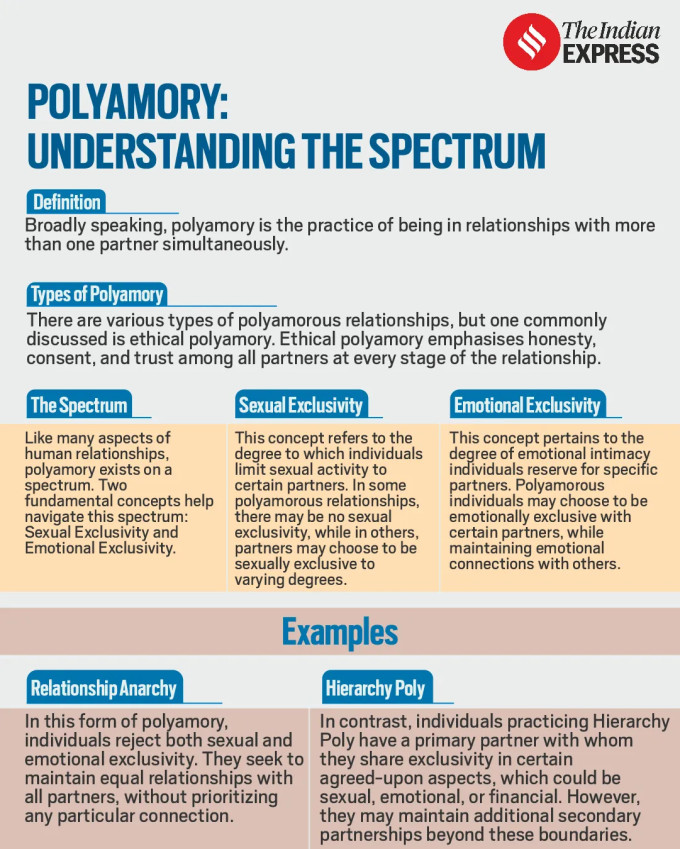‘Not another word for cheating’: Navigating polyamory in modern India and its gaining popularity
Recall Zoya Akhtar’s The Archies: A bright-eyed Archie Andrews (Agastya Nanda) confesses to Betty Cooper (Khushi Kapoor) and Veronica Lodge (Suhana Khan) that he loves them both and cannot choose. Perplexed, the girls exchange glances before collectively deciding to dump him. This brings us to a significant question — are our hearts constrained to loving only one?
While Archie’s ‘two-timing’ situation is not the best approach, an increasing number of individuals are turning to polyamorous relationships. In fact, according to Bumble’s recent study conducted in 2022, 61 per cent of single Indians surveyed were open to exploring ethical non-monogamy. Yet, as Anitha J, consultant clinical psychologist at Niyama Healthcare, noted, this phenomenon is hardly novel.

Non-monogamous relationships boast a lineage dating back to antiquity, evidenced in historical texts such as the Itihasas and Puranas, even manifesting in the epic Mahabharata where Draupadi is wedded to the five Pandava brothers, illustrating longstanding polyamorous dynamics in ancient cultures.
So, why do people opt for such relationships?
 A still from Archies comics.
A still from Archies comics.
Twenty-nine-year-old Vaishnavi Prabhu realised much later in life that she had the “capacity to receive and share love with more than just one person.” She also found out that being open to multiple partners could help her stay emotionally fulfilled. “I could have a partner for each facet of my life,” she said.
Reflecting on her journey, Prabhu said that her previous partner was romantic, but she yearned for someone who shared her passion for cinema. “Being polyamorous,” she mused, “opened up the possibilities.”
Swati Joshi, 29, also found herself stifled within the confines of monogamy. She believes that she has always been polyamorous but only recently found the “right vocabulary to navigate it.” “I learnt about polyamory through an acquaintance who talked about her journey. It fascinated me, so I researched online and found similar stories of people,” the Pune-based communications consultant shared.
At that moment, Joshi felt heard and seen. “Knowing that a practice like polyamory exists lifted a huge sense of guilt from my conscience,” she said.
Similarly, Swati Sangtani, 37, CEO of the Sangya Project, had a discussion with her husband eight years ago that opened them up to a polyamorous setup. “After this conversation, we began to realise that we all viewed relationships in a cookie-cutter format — a template of what is okay and what is not,” she said.
The two decided that the boundaries of their relationship depended solely on their equation, rather than societal norms. “We came to a conclusion that we both were fine with dating other people as long as there was full transparency and communication,” Sangtani said.
Rise in popularity
 Understanding polyamory. (Designed by Angshuman Maity)
Understanding polyamory. (Designed by Angshuman Maity)
While polyamorous relationships have historically operated discreetly under social and legal strictures, shifting tides of acceptance have fostered a more hospitable milieu for open discourse. “The growing acceptance of diverse sexual orientations, coupled with discussions around LGBTQ rights, has created a more supportive environment for individuals practising polyamory to openly share and discuss their experiences,” Anitha J said.
The term “polyamory,” coined in 1960 from Latin roots meaning ‘many loves’, may be relatively recent, said Dr Jitender Jakhar, consultant psychiatrist at Sitaram Bhartia Hospital, New Delhi.
However, he added that consensual non-monogamous arrangements, including polygamy, polyandry, and the French “menage à trois,” have historical antecedents.
“The practice of engaging in multiple romantic relationships with the consent of all involved has gained increased visibility and acceptance in recent years, thanks to changing cultural norms that challenge traditional relationship expectations. Positive media representation, including books, movies, and TV shows, also helps normalise consensual non-monogamy,” he explained.
Additionally, the evolving landscape of alternative relationship configurations reflects a growing realisation that there is no one-size-fits-all approach to relationships. “Individuals are now willing to explore other options when traditional monogamy does not align with their needs. Empowerment and individualism further contribute to the acceptance of polyamory, aligning with a societal trend where people seek relationships that offer personal fulfillment and self-expression,” Dr Jakhar said.
Couple’s therapist and dating coach Prachi Saxena Vaish attests to witnessing a surge in unconventional relationship structures, often stemming from past relational traumas. She clarified that while polyamory may manifest as a sexual orientation realised late due to societal conditioning, it can also denote a deliberate lifestyle choice adopted later in life.
Common misconceptions
 Debunking common misconceptions against polyamory. (Source: Freepik)
Debunking common misconceptions against polyamory. (Source: Freepik)
Prabhu has encountered numerous times that people perceived her polyamory as commitment issues and promiscuity. “When I put polyamorous as a part of my bio on a dating app, a lot of men assumed I was open to hookups,” she said.
Joshi also lamented the misperception of equating polyamory to infidelity. “Polyamory is viewed as a practice rooted in having sex with multiple people, but it is not another word for cheating,” she said. “It becomes hard for a lot of men to be okay with the idea of a ‘liberated’ woman because of ingrained societal biases. It can get quite lonely and isolating.”
In reality, Ananya Pant, a queer affirmative therapist and researcher, said that polyamory espouses values of honesty, trust, and communication. “If someone is cheating on another person under the name of being polyamorous, it is simply cheating and not polyamory. Ethically, a polyamorous person would always keep their situation right in front of you before they proceed with the relationship,” Pant mentioned.
Another myth is that there are no boundaries in polyamorous relationships. “Polyamory is essentially having multiple relationships requiring emotional investment like any relationship does — be it romantic or platonic. Being polyamorous does not mean that anything goes,” Sangtani said.
People also assume that those in ethically non-monogamous relationship structures aren’t serious about their partners or are incapable of experiencing deep love. “When you choose to date multiple people, you are also dealing with the emotional history and baggage that multiple people come with. This requires a level of communication and transparency that a lot of us often ignore. It also requires a lot of self-awareness. Caring for multiple people requires being present with each of them and making sure that they know exactly where they stand with you. It isn’t as simplistic as being greedy. Contrary to popular belief, it isn’t just an easy way out or an excuse to have light situations with multiple people,” Sangtani added.
One more misguided belief is that polyamory serves as a quick fix for existing relationship issues. “Polyamory demands even stronger communication and problem-solving skills. Introducing additional partners without addressing underlying problems can lead to complications rather than resolving issues,” said Dr Jakhar.
What to consider
View this post on Instagram
A post shared by Leanne Yau (@polyphiliablog)
Practising polyamory in a country like India presents several challenges compared to regions where it is legally accepted or more socially embraced. “The lack of acceptance and prevailing social stigma make it difficult for individuals in polyamorous relationships to openly practice and express their choices,” said Anitha J, adding that this can impede an individual’s autonomy and emotional well-being.
Another challenge is managing relationships with multiple partners. “A fast-paced lifestyle and demanding commitments already leave limited time for family life. Now, dividing that remaining time among multiple partners can be challenging,” Anitha J added.
Juggling the demands of multiple relationships may result in exhaustion and emotional strain, potentially affecting the overall health of the individual.
Jealousy might also arise. A 26-year-old digital marketer felt his primary partner become overly possessive when he spent time with his other partner. Things went further south when his partner asked him to date her exclusively. “I eventually ended things with both partners. After this ordeal, I am settling for monogamous relationships,” he said on condition of anonymity.
To combat this challenge, Vaish emphasises the importance of communication. “Polyamorous relationships flourish with clear, transparent communication. If something one of your partners is doing is sparking jealousy, talk to them about it and figure out the root of insecurity. Don’t be afraid to assert your boundaries when someone tries to encroach on yours.”
On the other hand, Dr Jakhar said effective planning is crucial before entering this dynamic. “Logistical challenges, such as coordinating schedules and living arrangements, require planning and adaptability. Time management to meet the needs of multiple partners necessitates careful scheduling and prioritisation.”
Before embarking on this journey, Vaish suggested individuals introspect and understand what they’re looking for. “A lot of people find the idea interesting and want to try it for ‘fun’ but remember it is your emotions at stake, as well as other people’s too.”
Pant also recommends people learn more about the practice before entering it. “Read articles, watch videos, hear from people who have lived experiences and educate yourself before you get into it. Finding like-minded individuals and a community can be vital for emotional support.”
In essence, polyamory is all about honesty, trust, and communication. “Recognise the importance of consent, respect for partners’ feelings, and continuous communication to foster a healthy and sustainable polyamorous dynamic,” Pant added.
Disclaimer: The copyright of this article belongs to the original author. Reposting this article is solely for the purpose of information dissemination and does not constitute any investment advice. If there is any infringement, please contact us immediately. We will make corrections or deletions as necessary. Thank you.





